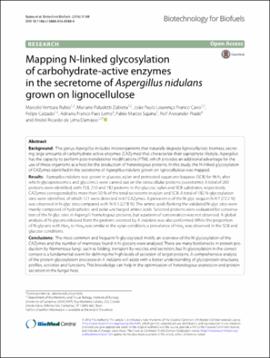| dc.contributor.author | Rubio, Marcelo Ventura | |
| dc.contributor.author | Zubieta, Mariane Paludetti | |
| dc.contributor.author | Cairo, Joao Paulo Lourenco Franco | |
| dc.contributor.author | Calzado, Felipe | |
| dc.contributor.author | Leme, Adriana Franco Paes | |
| dc.contributor.author | Squina, Fabio Marcio | |
| dc.contributor.author | Prade, Rolf Alexander | |
| dc.contributor.author | de Lima Damasio, Andre Ricardo | |
| dc.date.accessioned | 2018-11-09T21:10:42Z | |
| dc.date.available | 2018-11-09T21:10:42Z | |
| dc.date.issued | 2016-08-08 | |
| dc.identifier | oksd_delimadamasio_mappingn-linked_2016 | |
| dc.identifier.citation | Rubio, M. V., Zubieta, M. P., Cairo, J. P. L. F., Calzado, F., Leme, A. F. P., Squina, F. M., ... de Lima Damasio, A. R. (2016). Mapping N-linked glycosylation of carbohydrate-active enzymes in the secretome of Aspergillus nidulans grown on lignocellulose. Biotechnology for Biofuels, 9, Article 168. https://doi.org/10.1186/s13068-016-0580-4 | |
| dc.identifier.uri | https://hdl.handle.net/11244/302043 | |
| dc.description.abstract | Background: The genus Aspergillus includes microorganisms that naturally degrade lignocellulosic biomass, secreting large amounts of carbohydrate-active enzymes (CAZymes) that characterize their saprophyte lifestyle. Aspergillus has the capacity to perform post-translational modifications (PTM), which provides an additional advantage for the use of these organisms as a host for the production of heterologous proteins. In this study, the N-linked glycosylation of CAZymes identified in the secretome of Aspergillus nidulans grown on lignocellulose was mapped. | |
| dc.description.abstract | Results: Aspergillus nidulans was grown in glucose, xylan and pretreated sugarcane bagasse (SCB) for 96 h, after which glycoproteomics and glycomics were carried out on the extracellular proteins (secretome). A total of 265 proteins were identified, with 153, 210 and 182 proteins in the glucose, xylan and SCB substrates, respectively. CAZymes corresponded to more than 50 % of the total secretome in xylan and SCB. A total of 182 N-glycosylation sites were identified, of which 121 were detected in 67 CAZymes. A prevalence of the N-glyc sequon N-X-T (72.2 %) was observed in N-glyc sites compared with N-X-S (27.8 %). The amino acids flanking the validated N-glyc sites were mainly composed of hydrophobic and polar uncharged amino acids. Selected proteins were evaluated for conservation of the N-glyc sites in Aspergilli homologous proteins, but a pattern of conservation was not observed. A global analysis of N-glycans released from the proteins secreted by A. nidulans was also performed. While the proportion of N-glycans with Hex5 to Hex9 was similar in the xylan condition, a prevalence of Hex5 was observed in the SCB and glucose conditions. | |
| dc.description.abstract | Conclusions: The most common and frequent N-glycosylated motifs, an overview of the N-glycosylation of the CAZymes and the number of mannoses found in N-glycans were analyzed. There are many bottlenecks in protein production by filamentous fungi, such as folding, transport by vesicles and secretion, but N-glycosylation in the correct context is a fundamental event for defining the high levels of secretion of target proteins. A comprehensive analysis of the protein glycosylation processes in A. nidulans will assist with a better understanding of glycoprotein structures, profiles, activities and functions. This knowledge can help in the optimization of heterologous expression and protein secretion in the fungal host. | |
| dc.format | application/pdf | |
| dc.language | en_US | |
| dc.publisher | BioMed Central | |
| dc.rights | This material has been previously published. In the Oklahoma State University Library's institutional repository this version is made available through the open access principles and the terms of agreement/consent between the author(s) and the publisher. The permission policy on the use, reproduction or distribution of the material falls under fair use for educational, scholarship, and research purposes. Contact Digital Resources and Discovery Services at lib-dls@okstate.edu or 405-744-9161 for further information. | |
| dc.title | Mapping N-linked glycosylation of carbohydrate-active enzymes in the secretome of Aspergillus nidulans grown on lignocellulose | |
| osu.filename | oksd_delimadamasio_mappingn-linked_2016.pdf | |
| dc.description.peerreview | Peer reviewed | |
| dc.identifier.doi | 10.1186/s13068-016-0580-4 | |
| dc.description.department | Microbiology and Molecular Genetics | |
| dc.type.genre | Article | |
| dc.type.material | Text | |
| dc.subject.keywords | glycoproteomics | |
| dc.subject.keywords | aspergillus nidulans | |
| dc.subject.keywords | carbohydrate-active enzymes | |
| dc.subject.keywords | glycoside hydrolases | |
| dc.subject.keywords | n-glycosylation | |
| dc.subject.keywords | heterologous expression | |
